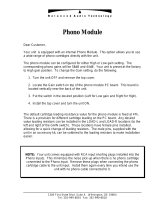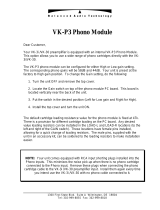
2
Copyright 2016 © by McIntosh Laboratory, Inc.
Table of Contents
Customer Service
If it is determined that your McIntosh product is in
need of repair, you can return it to your Dealer. You
can also return it to the McIntosh Laboratory Service
Department. For assistance on factory repair return
procedure, contact the McIntosh Service Department
at:
McIntosh Laboratory, Inc.
2 Chambers Street
Binghamton, New York 13903
Phone: 607-723-3515
Fax: 607-723-1917
Safety Instructions ..................................................... 2
(Separate Sheet) ................... Important Additional
Operation Information Guide
Thank You and Please Take a Moment ...................... 2
Technical Assistance and Customer Service ............. 2
Table of Contents ....................................................... 2
General Information .................................................. 3
Connector and Cable Information ............................. 3
Introduction ................................................................ 4
Performance Features ............................................. 4-5
Dimensions ................................................................ 6
Installation ................................................................. 7
Connections:
Rear Panel Connections .............................................. 8
Connecting Components ............................................. 9
Front Panel:
Front Panel Displays, Controls, Push-buttons .......... 10
Front Panel Information Displays Modes ..................11
Remote Control:
HR090 Remote Control Push-buttons ...................... 12
Setup:
How to Operate the Setup Mode .............................. 13
Default Settings, Firmware Version .......................... 13
Input Settings ....................................................... 13-14
Rename Input ............................................................ 14
Profile Store .............................................................. 15
Digital Output ........................................................... 16
Tube Lights ............................................................... 16
Power Mode .............................................................. 16
IR Sensor................................................................... 17
Factory Reset ............................................................ 17
Operation:
How to Operate the MP1100 ................................18-23
Trim Functions ..................................................... 18-22
Mute, Trim and Output Meters ................................. 23
USB Input and Installing Software ......................24-26
Reset of Microprocessors .......................................... 25
Graphic Curves .................................................... 27-28
Rumble and Scratch Filter Curves ............................ 28
Additional Information:
Photo ......................................................................... 29
Specifications ............................................................ 30
Packing Instruction ................................................... 31
Important Safety Information is supplied in a separate document “Important Additional Operation Information Guide”
Your decision to own this McIntosh MP1100 Phono
Preamplifier ranks you at the very top among discrim-
inating music listeners. You now have “The Best.”
The McIntosh dedication to “Quality,” is assurance
that you will receive many years of musical enjoyment
from this unit.
Please take a short time to read the information in
this manual. We want you to be as familiar as pos-
sible with all the features and functions of your new
McIntosh.
Thank You
Please Take A Moment
Technical Assistance
If at any time you have questions about your McIntosh
product, contact your McIntosh Dealer who is familiar
with your McIntosh equipment and any other brands
that may be part of your system. If you or your Dealer
wish additional help concerning a suspected problem,
you can receive technical assistance for all McIntosh
products at:
McIntosh Laboratory, Inc.
2 Chambers Street
Binghamton, New York 13903
Phone: 607-723-3512
Fax: 607-724-0549
The serial number, purchase date and McIntosh Dealer
name are important to you for possible insurance
claim or future service. The spaces below have been
provided for you to record that information:
Serial Number: _______________________________
Purchase Date: _______________________________
Dealer Name: ________________________________























